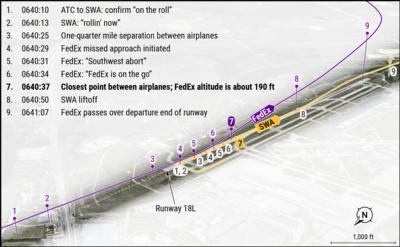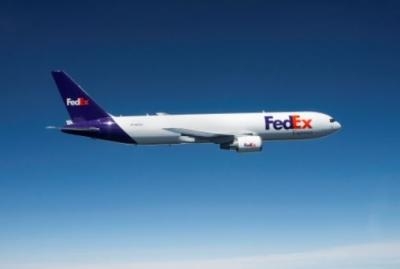FAA Recently Announced That It Would Be Installing A Surface Detection System At Some Airports, Including Austin
The National Transportation Safety Board found that the lack of critical safety technology and incorrect assumptions by an air traffic controller led to a near-collision between a Southwest Airlines B-737 and FedEx B-767 on an Austin, Texas runway last year.

On the morning of Feb. 4, 2023, Austin-Bergstrom International Airport was covered with dense fog, limiting visibility for air traffic controllers and flight crews. The air traffic control tower did not have surface detection equipment to aid controllers in monitoring traffic on the taxiway and runway.
Just after 6:34 a.m., when FedEx flight 1432 was about six minutes from the airport with three crew onboard, the controller cleared the airplane to land.
About four minutes later, the Southwest flight, carrying 128 passengers and crew, indicated it was ready to depart on the same runway the FedEx flight had been cleared to land on. The FedEx plane was about four miles and 90 seconds from the runway threshold at this point.
Unable to see the Southwest 737 through the dense fog, the controller assumed it was already at the hold short line, which is a taxiway marking that indicates where an aircraft must stop to receive clearance to enter the assigned runway if that clearance was not already provided. The Southwest flight was about 550 feet away from the hold short line when the crew said that the airplane was ready to depart, and another 57 seconds elapsed as the crew taxied the plane before reaching the runway surface. At this point, FedEx was two miles from the threshold of the runway. After an additional 11 seconds, Southwest was aligned with the runway centerline.

Southwest’s flight crewmembers ran the airplane’s engines in accordance with their airline’s procedures when departing in near-freezing conditions, delaying takeoff 19 more seconds.
When FedEx was on short final approach, the first officer managed to see the Southwest 737’s “left white position light” followed by its “silhouette” as the 737 was just ahead of FedEx and rolling down the runway. The FedEx captain initiated a missed approach. At the closest point, the two airplanes came within about 150 to 170 feet of each other.
The Southwest flight continued its takeoff and flew to its destination of Cancun, Mexico; after the go-around, the FedEx airplane landed without further incident in Austin. No injuries were reported among the passengers and crew on Southwest or to the three crew members aboard FedEx.
“One missed warning, one incorrect response, even one missed opportunity to strengthen safety can lead to tragedy and destroy public confidence in our aviation system, which is precisely why we must learn from near misses such as these,” said NTSB Chair Jennifer Homendy. “We are once again calling on the FAA to use technology to prevent runway incursions — something we’ve been doing for decades — because we must back up the humans operating in our aviation system at every level. That is how we save lives.”
Investigators said that the runway incursion could have been avoided had the controller held Southwest until after FedEx had landed, or cancelled Southwest’s takeoff clearance and told FedEx to go around.
The NTSB also said the Southwest flight crew, who was aware that FedEx was on short final approach, contributed to the incident by failing to notify the controller that they would need more time on the runway to do the engine run-up prior to takeoff.
The NTSB linked aspects of the Austin incident to its investigation of the January 2023 runway incursion at New York’s John F. Kennedy Airport saying that had Austin been equipped with surface detection equipment, as JFK Airport was, the controller could have been alerted to the insufficient separation between the two airplanes and taken action to avoid the conflict.

The NTSB recommended that the Federal Aviation Administration require all U.S. airports that have scheduled air carrier operations but don’t have a surface detection system, be equipped with a system that tracks the movement of aircraft, determines their proximity to each other, and provides air traffic controllers with visual and aural cues of their surface movements.
The FAA recently announced that it would be installing a surface detection system at some airports, including Austin, by the end of 2025. The NTSB has said that since the system had yet to be deployed at any airports, it couldn’t yet determine if the system would address all the elements of its recommendation.
In the investigation into the JFK runway incursion, the NTSB recommended the FAA collaborate with aircraft and avionics manufacturers to develop a system that would alert flight crews of traffic on a runway or taxiway and traffic on approach to land and require that both newly manufactured and existing transport category airplanes have such systems installed. The NTSB reiterated that recommendation in its Austin report.
Additionally, the NTSB recommended that the FAA require additional training on low-visibility operations at all operating air traffic control towers.
The final incident report will be available in several weeks.
 Aero-FAQ: Dave Juwel's Aviation Marketing Stories -- ITBOA BNITBOB
Aero-FAQ: Dave Juwel's Aviation Marketing Stories -- ITBOA BNITBOB NTSB Prelim: Rutan Long-EZ
NTSB Prelim: Rutan Long-EZ ANN's Daily Aero-Term (12.05.25): Hazardous Weather Information
ANN's Daily Aero-Term (12.05.25): Hazardous Weather Information Aero-News: Quote of the Day (12.05.25)
Aero-News: Quote of the Day (12.05.25) Airborne-Flight Training 12.04.25: Ldg Fee Danger, Av Mental Health, PC-7 MKX
Airborne-Flight Training 12.04.25: Ldg Fee Danger, Av Mental Health, PC-7 MKX





